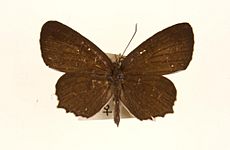Angled darkie facts for kids
Quick facts for kids Angled Darkie |
|
|---|---|
 |
|
| Museum specimen from Malaya | |
| Scientific classification | |
| Kingdom: | |
| Phylum: | |
| Class: | |
| Order: | |
| Superfamily: | |
| Family: | |
| Genus: | |
| Species: |
A. fabius
|
| Binomial name | |
| Allotinus fabius (Distant & Pryer, 1887)
|
|
The Angled Darkie (Allotinus fabius) is a small and interesting butterfly. It is known for its unique appearance. This butterfly lives in parts of Asia, including India, Myanmar, and other countries in Southeast Asia. It belongs to a group of butterflies called the Lycaenidae family. This family is also known as "gossamer-winged butterflies."
Contents
What is the Angled Darkie?
The Angled Darkie is a type of butterfly. It is part of the Allotinus genus. This means it shares many features with other butterflies in this group. Butterflies are insects with four wings. They are often colorful and fly during the day. The Angled Darkie is a smaller butterfly.
Why is it Called "Angled Darkie"?
The name "Angled Darkie" comes from its appearance. "Darkie" likely refers to its generally dark colors. These can be shades of brown or grey. The "Angled" part might describe the shape of its wings. Many butterflies have specific angles or shapes to their wings. These shapes help them fly or blend in with their surroundings.
Where Does the Angled Darkie Live?
The Angled Darkie butterfly lives in tropical and subtropical regions. Its main homes are in India and Myanmar. It is also found across many countries in Southeast Asia. This includes places like the Malay Peninsula. These areas have warm climates. They also have lots of plants and trees. These are perfect for butterflies to live and find food.
Its Natural Habitat
Angled Darkies prefer certain types of places. They often live in forests. These can be lowland forests or areas with dense plant growth. They need places where they can find nectar from flowers. They also need specific plants for their caterpillars to eat. The warm, humid weather in Southeast Asia is ideal for them.
What Does the Angled Darkie Look Like?
The Angled Darkie is a small butterfly. Its wings are usually dark in color. They can be dark brown or grey. Some might have faint markings. These markings help them blend in with their environment. This is a good way to hide from predators.
Size and Markings
Like most butterflies, the Angled Darkie has two pairs of wings. It has a body divided into three parts: head, thorax, and abdomen. It also has six legs and two antennae. The antennae help it smell and feel its way around. The exact size can vary. However, it is generally considered a small butterfly.
The Life Cycle of a Butterfly
All butterflies, including the Angled Darkie, go through a fascinating life cycle. This process is called metamorphosis. It has four main stages.
Stage 1: The Egg
The life cycle begins when a female butterfly lays tiny eggs. She usually places them on a specific "host plant." This plant will be the first food for the caterpillar.
Stage 2: The Larva (Caterpillar)
Once the egg hatches, a larva emerges. This is what we call a caterpillar. The caterpillar's main job is to eat and grow. It eats leaves from the host plant. As it grows, it sheds its skin several times. This is called molting.
Stage 3: The Pupa
After growing big enough, the caterpillar forms a pupa. For butterflies, this is often called a chrysalis. Inside the chrysalis, amazing changes happen. The caterpillar's body transforms into a butterfly. This stage can last for weeks or months.
Stage 4: The Adult Butterfly
Finally, the adult butterfly emerges from the chrysalis. It has wings and can fly. The adult butterfly's main jobs are to drink nectar from flowers and to mate. Female butterflies then lay eggs, starting the cycle all over again.
What Do Angled Darkies Eat?
Adult Angled Darkie butterflies mainly feed on nectar. Nectar is a sweet liquid found in flowers. They use a long, tube-like mouthpart called a proboscis to sip the nectar. This gives them energy to fly and live.
Caterpillar Diet
The caterpillars of the Angled Darkie have a different diet. They eat the leaves of specific plants. These are called host plants. The type of host plant can vary. It depends on the specific species of butterfly. The caterpillars need these plants to grow and get ready for the pupa stage.
Conservation of Butterflies
Butterflies like the Angled Darkie are important parts of their ecosystems. They help pollinate plants. This means they help plants make seeds and fruits. Many butterfly species face challenges. These include habitat loss and climate change. Protecting their habitats is important for their survival.

